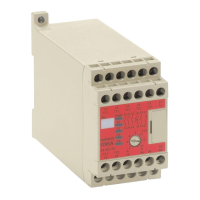Selecting Relays
A Mounting Structure and Type of Protection
-
-1 Type of Protection
If a Relay is selected that does not have the appropriate type of
protection for the atmosphere and the mounting conditions, it may
cause problems, such as contact failure.
Refer to the type of protection classifications shown in the following
table and select a Relay suitable to the atmosphere in which it is to
be used.
Classification by Type of Protection
B-A-2 Combining Relays and Sockets
Use OMRON Relays in combination with specified OMRON Sockets.
If the Relays are used with sockets from other manufacturers, it may
cause problems, such as abnormal heating at the mating point due to
differences in power capacity and mating properties.
B-A-3 Using Relays in Atmospheres Subject to Dust
If a Relay is used in an atmosphere subject to dust, dust will enter
the Relay, become lodged between contacts, and cause the circuit to
fail to close. Moreover, if conductive material such as wire clippings
enter the Relay, it will cause contact failure and short-circuiting.
Implement measures to protect against dust as required by the
application.
B Drive Circuits
B-B-1 Providing Power Continuously for Long Periods
If power is continuously provided to the coil for a long period,
deterioration of coil insulation will be accelerated due to heating of
the coil. Also see 3-2-7 Using with Infrequent Switching.
B-B-2 Operation Checks for Inspection and
Maintenance
If a socket with an operation indicator is used, Relay status during
operation can be shown by means of the indicator, thereby facilitating
inspection and maintenance.
Note: The built-in indicator shows that power is being provided to the
coil. The indicator is not based on contact operation.
C Loads
B-C-1 Contact Ratings
Contact ratings are generally shown for resistance loads and
inductive loads.
B-C-2 Using Relays with a Microload
Check the failure rate in the performance tables for individual
products.
Item Features Representative model Atmosphere conditions
Mounting
structure
Type of
protection
Dust and dirt Corrosive
gases
PCB-mounted
Relay
Flux protection Structure that
helps prevent
flux from
entering Relays
during soldering
G7SA Some protection
(No large dust or
dirt particles
inside Relay.)
No protection
Unsealed Structure that
protects against
contact with
foreign material
by means of
enclosure in a
case (designed
for manual
soldering)
G7S
Type Description Examples of
applicable models
Built-in indicator LED G7S
G7SA
http://www.ia.omron.com/
C-4
(c)Copyright OMRON Corporation 2007 All Rights Reserved.
Artisan Technology Group - Quality Instrumentation ... Guaranteed | (888) 88-SOURCE | www.artisantg.com

